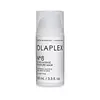What's inside
What's inside
 Key Ingredients
Key Ingredients

 Benefits
Benefits

 Concerns
Concerns

No concerns
 Ingredients Side-by-side
Ingredients Side-by-side

Water
Skin ConditioningPisum Sativum Peptide
Skin ConditioningBetaine
HumectantGlycerin
HumectantPanthenol
Skin ConditioningPEG-40 Hydrogenated Castor Oil
EmulsifyingPhenoxyethanol
PreservativePolyquaternium-37
Citronellyl Methylcrotonate
MaskingEthylhexylglycerin
Skin ConditioningCeratonia Siliqua Seed Extract
Skin ConditioningHydrolyzed Soy Protein
HumectantZea Mays Starch
AbsorbentLeuconostoc/Radish Root Ferment Filtrate
AntimicrobialTrisodium Ethylenediamine Disuccinate
Polyquaternium-16
Potassium Sorbate
PreservativeSodium Benzoate
MaskingGuar Hydroxypropyltrimonium Chloride
Skin ConditioningPolyquaternium-7
Water, Pisum Sativum Peptide, Betaine, Glycerin, Panthenol, PEG-40 Hydrogenated Castor Oil, Phenoxyethanol, Polyquaternium-37, Citronellyl Methylcrotonate, Ethylhexylglycerin, Ceratonia Siliqua Seed Extract, Hydrolyzed Soy Protein, Zea Mays Starch, Leuconostoc/Radish Root Ferment Filtrate, Trisodium Ethylenediamine Disuccinate, Polyquaternium-16, Potassium Sorbate, Sodium Benzoate, Guar Hydroxypropyltrimonium Chloride, Polyquaternium-7
Water
Skin ConditioningDimethicone
EmollientCetyl Alcohol
EmollientPersea Gratissima Oil
Skin ConditioningGlycerin
HumectantStearyl Alcohol
EmollientEthylhexyl Olivate
Skin ConditioningBehentrimonium Chloride
PreservativeCetrimonium Bromide
AntimicrobialLimnanthes Alba Seed Oil
Skin ConditioningOryza Sativa Bran Oil
EmollientQuaternium-80
Squalane
EmollientRosa Canina Seed Extract
EmollientCeramide AP
Skin ConditioningCeramide NP
Skin ConditioningHydrolyzed Jojoba Esters
Skin ConditioningSodium Hyaluronate
HumectantSodium PCA
HumectantBis-Aminopropyl Diglycol Dimaleate
Skin ConditioningArginine
MaskingJojoba Esters
EmollientPanthenol
Skin ConditioningCarthamus Tinctorius Seed Oil
MaskingCannabis Sativa Seed Oil
EmollientGlycine
BufferingAlanine
MaskingSerine
MaskingValine
MaskingIsoleucine
Skin ConditioningProline
Skin ConditioningThreonine
Guar Hydroxypropyltrimonium Chloride
Skin ConditioningHistidine
HumectantHydroxyethylcellulose
Emulsion StabilisingPhenylalanine
MaskingAspartic Acid
MaskingPCA
HumectantPhosphatidylcholine
EmulsifyingCitric Acid
BufferingSodium Lactate
BufferingEthylhexylglycerin
Skin ConditioningSodium Benzoate
MaskingPhenoxyethanol
PreservativeBis-Cetearyl Amodimethicone
Propylene Glycol
HumectantIsopropyl Alcohol
SolventSodium Nitrate
SoothingTocopherol
AntioxidantParfum
MaskingCitral
PerfumingHexyl Cinnamal
PerfumingLimonene
PerfumingWater, Dimethicone, Cetyl Alcohol, Persea Gratissima Oil, Glycerin, Stearyl Alcohol, Ethylhexyl Olivate, Behentrimonium Chloride, Cetrimonium Bromide, Limnanthes Alba Seed Oil, Oryza Sativa Bran Oil, Quaternium-80, Squalane, Rosa Canina Seed Extract, Ceramide AP, Ceramide NP, Hydrolyzed Jojoba Esters, Sodium Hyaluronate, Sodium PCA, Bis-Aminopropyl Diglycol Dimaleate, Arginine, Jojoba Esters, Panthenol, Carthamus Tinctorius Seed Oil, Cannabis Sativa Seed Oil, Glycine, Alanine, Serine, Valine, Isoleucine, Proline, Threonine, Guar Hydroxypropyltrimonium Chloride, Histidine, Hydroxyethylcellulose, Phenylalanine, Aspartic Acid, PCA, Phosphatidylcholine, Citric Acid, Sodium Lactate, Ethylhexylglycerin, Sodium Benzoate, Phenoxyethanol, Bis-Cetearyl Amodimethicone, Propylene Glycol, Isopropyl Alcohol, Sodium Nitrate, Tocopherol, Parfum, Citral, Hexyl Cinnamal, Limonene
 Reviews
Reviews

Ingredients Explained
These ingredients are found in both products.
Ingredients higher up in an ingredient list are typically present in a larger amount.
Ethylhexylglycerin (we can't pronounce this either) is commonly used as a preservative and skin softener. It is derived from glyceryl.
You might see Ethylhexylglycerin often paired with other preservatives such as phenoxyethanol. Ethylhexylglycerin has been found to increase the effectiveness of these other preservatives.
Glycerin is already naturally found in your skin. It helps moisturize and protect your skin.
A study from 2016 found glycerin to be more effective as a humectant than AHAs and hyaluronic acid.
As a humectant, it helps the skin stay hydrated by pulling moisture to your skin. The low molecular weight of glycerin allows it to pull moisture into the deeper layers of your skin.
Hydrated skin improves your skin barrier; Your skin barrier helps protect against irritants and bacteria.
Glycerin has also been found to have antimicrobial and antiviral properties. Due to these properties, glycerin is often used in wound and burn treatments.
In cosmetics, glycerin is usually derived from plants such as soybean or palm. However, it can also be sourced from animals, such as tallow or animal fat.
This ingredient is organic, colorless, odorless, and non-toxic.
Glycerin is the name for this ingredient in American English. British English uses Glycerol/Glycerine.
Learn more about GlycerinThis ingredient is derived from guar gum.
It is a conditioning ingredient, meaning it helps soften skin and hair.
Panthenol is a common ingredient that helps hydrate and soothe the skin. It is found naturally in our skin and hair.
There are two forms of panthenol: D and L.
D-panthenol is also known as dexpanthenol. Most cosmetics use dexpanthenol or a mixture of D and L-panthenol.
Panthenol is famous due to its ability to go deeper into the skin's layers. Using this ingredient has numerous pros (and no cons):
Like hyaluronic acid, panthenol is a humectant. Humectants are able to bind and hold large amounts of water to keep skin hydrated.
This ingredient works well for wound healing. It works by increasing tissue in the wound and helps close open wounds.
Once oxidized, panthenol converts to pantothenic acid. Panthothenic acid is found in all living cells.
This ingredient is also referred to as pro-vitamin B5.
Learn more about PanthenolPhenoxyethanol is a preservative that has germicide, antimicrobial, and aromatic properties. Studies show that phenoxyethanol can prevent microbial growth. By itself, it has a scent that is similar to that of a rose.
It's often used in formulations along with Caprylyl Glycol to preserve the shelf life of products.
Sodium Benzoate is a preservative. It's used in both cosmetic and food products to inhibit the growth of mold and bacteria. It is typically produced synthetically.
Both the US FDA and EU Health Committee have approved the use of sodium benzoate. In the US, levels of 0.1% (of the total product) are allowed.
Sodium benzoate works as a preservative by inhibiting the growth of bacteria inside of cells. It prevents the cell from fermenting a type of sugar using an enzyme called phosphofructokinase.
It is the salt of benzoic acid. Foods containing sodium benzoate include soda, salad dressings, condiments, fruit juices, wines, and snack foods.
Studies for using ascorbic acid and sodium benzoate in cosmetics are lacking, especially in skincare routines with multiple steps.
We always recommend speaking with a professional, such as a dermatologist, if you have any concerns.
Learn more about Sodium BenzoateWater. It's the most common cosmetic ingredient of all. You'll usually see it at the top of ingredient lists, meaning that it makes up the largest part of the product.
So why is it so popular? Water most often acts as a solvent - this means that it helps dissolve other ingredients into the formulation.
You'll also recognize water as that liquid we all need to stay alive. If you see this, drink a glass of water. Stay hydrated!
Learn more about Water